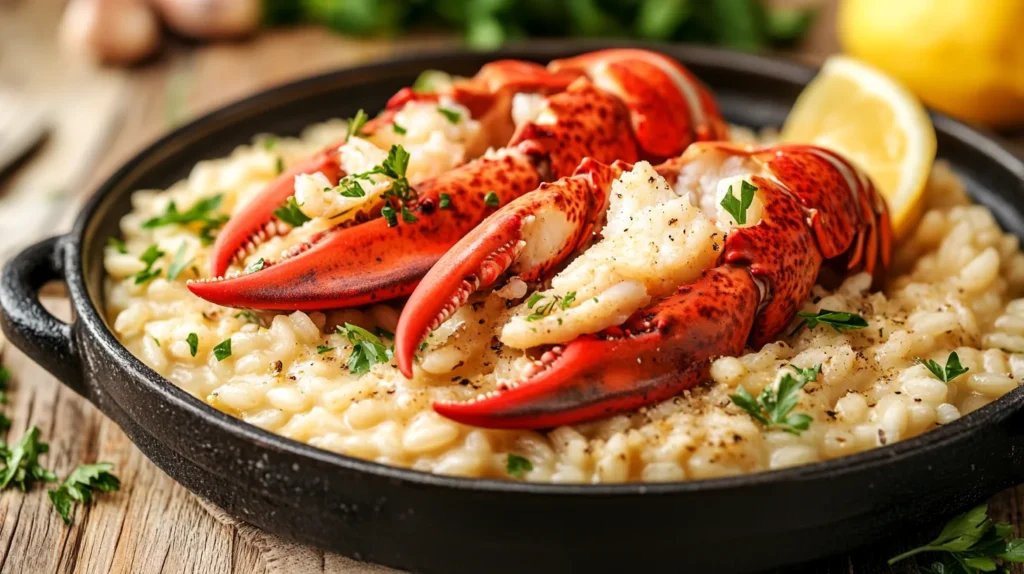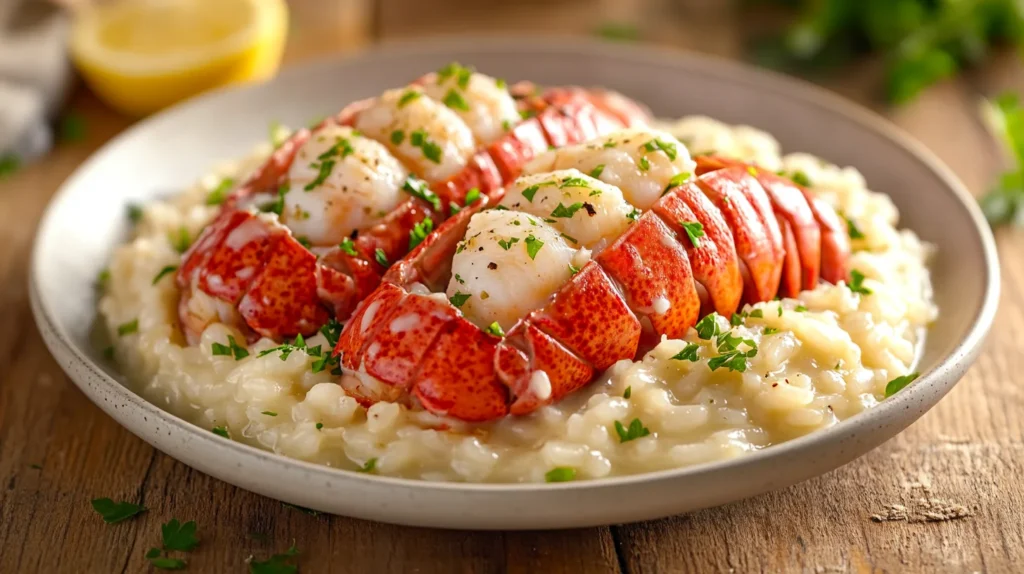How to Store Leftover Lobster Tails ?- A Comprehensive Guide for Seafood Lovers
How to Store Leftover Lobster Tails? This question often arises after a delightful seafood feast when you’re left with those succulent morsels that deserve a second chance to shine. Properly storing leftover lobster tails is essential to maintaining their flavor and texture, ensuring you can enjoy them in innovative ways later on.
Leftover lobster tails are a fantastic ingredient that can be transformed into several mouthwatering dishes. Whether you’re making a quick lobster salad, a luxurious lobster bisque, or a savory lobster pasta, there are endless possibilities to explore. For a simple yet irresistible recipe, why not try Garlic Butter Lobster Tails? This flavorful dish is the perfect way to enjoy leftover lobster in a new and exciting way.
For the full recipe and detailed instructions, click here to discover how to make Garlic Butter Lobster Tails.
Understanding Lobster Tails and Their Shelf Life
Lobster tails are a delicacy enjoyed by many, known for their sweet, tender meat and versatility in various dishes. However, like all fresh seafood, understanding their shelf life is crucial for food safety and quality preservation. The freshness of your lobster tails directly impacts the taste and texture of your meals, so let’s delve into what makes these shells of goodness tick.
Nutritional Value of Leftover Lobster Tails
Lobster tails are not only delicious but also packed with nutrients that make them a healthy addition to your diet. They are a rich source of high-quality protein, essential fatty acids, vitamins, and minerals.
The protein found in lobster tails contributes to muscle growth and repair, making it an excellent choice for those looking to maintain a balanced diet. Furthermore, lobster is low in calories and saturated fats, which makes it a heart-healthy option.
Beyond protein, lobster tails are abundant in omega-3 fatty acids, which are known for their anti-inflammatory properties and benefits to heart health. Additionally, they contain important vitamins like B12 and minerals such as zinc and selenium, which support immune health and metabolic functions.
Understanding this nutritional profile allows you to appreciate not just the exquisite taste of lobster tails but also the health benefits they bring to your table.
Freshness Indicators for Leftover Lobster Tails
Identifying the freshness of lobster tails is vital to ensure you’re consuming quality seafood. When purchasing or storing leftover lobster, look for key indicators that reveal whether the tails have maintained their freshness.
First, examine the color of the shell. Fresh lobster tails typically exhibit a vibrant hue. Grayish or discolored shells may suggest aging, while an unpleasant odor—often compared to ammonia—can indicate spoilage.
Next, consider the texture. Fresh lobster tails should feel firm to the touch. If they appear slimy or overly soft, they may no longer be safe to consume.
Finally, checking the sell-by date on packaged lobster tails can provide additional assurance, but trust your senses above all else. Knowing these indicators will help you determine the best time to cook and store your leftover lobster tails.

Ideal Storage Duration for Cooked Leftover Lobster Tails
Once cooked, lobster tails can be stored safely for a limited time. Ideally, cooked lobster tails should be consumed within two days if refrigerated. However, if you plan to keep them longer, freezing is the best option.
When stored in the refrigerator, ensure they are placed in an airtight container to minimize exposure to air and moisture, which can lead to contamination and spoilage.
If properly frozen, lobster tails can last for several months—up to six months for optimal flavor and texture. Over time, however, even frozen lobster tails can develop freezer burn, which affects both taste and texture. By understanding ideal storage durations, you can maximize the enjoyment of your leftover lobster tails.
Preparing Lobster Tails for Storage
Before delving into the methods of storage, it’s crucial to prepare your lobster tails correctly. Proper preparation involves cooling, removing the meat from the shell, and wrapping them securely. Each step plays a pivotal role in ensuring the integrity of the flavors and textures remain intact.
Cooling Lobster Tails Properly
After enjoying your Leftover Lobster Tails, the first task is to allow them to cool down properly. This step is essential to avoid bacterial growth, which occurs when food is left out at room temperature for too long.
To cool Leftover Lobster Tails effectively, place them on a plate or cutting board and let them sit for about 30 minutes to an hour. If you’re pressed for time, you can immerse them in an ice bath—a large bowl filled with ice water—to expedite the cooling process.
By ensuring that the lobster tails reach a safe cooling temperature, you’ll set the stage for successful storage.
Removing Meat from the Shell
Removing the meat from the shell is a smart way to save space in your refrigerator or freezer. It also helps in preparing the lobster for future recipes, making it easier to utilize in a variety of dishes later on.
To do this, start by using kitchen shears to cut along the top of the shell lengthwise. Carefully peel back the shell to expose the meat, allowing it to rest on one side. You may need to use a fork or your fingers to gently detach any remaining bits of meat from the shell.
Take care to keep the meat intact as much as possible to preserve its texture. Removing the meat not only aids in storage but also sets you up for quick meal preparation in the future.
Best Practices for Wrapping and Sealing
Once you have prepared the lobster meat, it’s time to wrap and seal it properly for storage. Secure wrapping helps prevent air exposure, which can lead to freezer burn or spoilage.
Start by placing the lobster meat in a resealable plastic bag or an airtight container. If using a bag, press out as much air as possible before sealing. For additional protection, consider wrapping the meat in plastic wrap before placing it in the bag to double seal against air exposure.
Label the packaging with the date, so you can easily track how long the lobster has been stored. These simple best practices will help retain the quality of your leftover lobster tails.

Methods of Storing Lobster Tails
With your Leftover Lobster Tails prepared for storage, let’s explore the different methods available. Depending on your plans for future culinary adventures, you might choose refrigeration or freezing, each offering its advantages and nuances.
Refrigeration Techniques
Refrigeration is a straightforward method for short-term storage of leftover lobster tails—ideal if you plan to consume them within a couple of days.
To refrigerate your Leftover Lobster Tails properly, place them in an airtight container. Ensure that the container is placed in the coldest part of your refrigerator—usually towards the back—where temperatures tend to remain stable.
Avoid storing Leftover Lobster Tails in the fridge door, as the temperature fluctuates due to frequent opening and closing. Keeping them sealed tightly prevents odors from contaminating the delicate flavor of the seafood.
It’s worth noting that the faster you consume refrigerated Leftover Lobster Tails, the better the taste and texture will be. Utilize this method when you’re in the mood for a quick seafood fix!
Freezing Lobster Tails: Step-by-Step
Freezing is the best approach when you want to keep lobster tails for an extended period. Doing it right ensures that you maintain the quality of the meat during the freezing process.
Begin by preparing the lobster meat as previously described—cooling, removing from the shell, and wrapping securely. Once ready, place the wrapped lobster in a freezer-safe bag or container.
For optimal results, aim to freeze the lobster tails at a consistent temperature of zero degrees Fahrenheit. Make sure to remove as much air as possible to prevent freezer burn. Additionally, try to use the lobster within three to six months to ensure peak flavor.
When you’re ready to use the frozen lobster tails, you’ll appreciate the foresight taken during this step, knowing that you’ve preserved their deliciousness for future meals.
Using Vacuum Sealers for Long-Term Storage
For seafood enthusiasts who frequently stock up on lobster tails, investing in a vacuum sealer could be worthwhile. This method extends the shelf life of your lobster tails while safeguarding their delicate flavors.
A vacuum sealer removes air from special bags, creating a tight seal around the food. This significantly reduces the risk of freezer burn and oxidation, keeping your lobster tails fresher for longer periods.
To use a vacuum sealer, follow the same steps of cooling and removing meat from the shell. Place the meat in vacuum-sealing bags and run the machine according to the manufacturer’s instructions. Once sealed, label the bags with dates for easy tracking.
Vacuum sealing not only enhances longevity but also provides convenience when it comes to meal prep. You’ll find yourself reaching for those perfectly preserved lobster tails with ease.
Thawing and Reheating Leftover Lobster Tails
Understanding how to thaw and reheat your leftover lobster tails properly is equally crucial for preserving their delightful texture and flavor. Mistakes in this area can result in rubbery or overcooked meat, diminishing the enjoyment of your dish.
Safe Thawing Methods
Thawing lobster tails must be approached with care to ensure food safety. The best practice is to plan ahead and let your frozen lobster tails thaw overnight in the refrigerator. This slow thawing allows the meat to defrost evenly, minimizing damage to the texture.
If you’re short on time, you can opt for a quicker method by submerging the lobster tails in cold water. Ensure the packaging remains intact to prevent water from entering. Change the water every 30 minutes until thawed, which should take about an hour depending on the quantity.
Avoid thawing seafood at room temperature, as this can promote bacterial growth. Safe thawing guarantees a flavorful experience with your leftover lobster tails.
Techniques for Reheating Lobster Tails
Once your lobster tails are thawed, reheating requires careful attention to retain their delectable qualities. There are several methods to achieve this, including steaming, grilling, and baking.
Steaming is one of the gentlest methods, helping to infuse moisture back into the meat. Simply place the lobster tails in a steamer basket over boiling water for about five to seven minutes, or until heated through.
Grilling adds a charred flavor that complements the sweetness of the lobster. Preheat the grill, lightly oil the grates, and grill the tails cut-side down for a few minutes before flipping to finish cooking.
Baking is another option; preheat your oven to 350°F and bake the lobster tails for approximately 10 minutes, basting with butter for extra flavor.
Whichever method you choose, ensure the internal temperature reaches 145°F to guarantee thorough heating.

Common Mistakes to Avoid
While reheating lobster tails may seem straightforward, there are common pitfalls to watch out for. One major mistake is reheating at too high a temperature, leading to tough and rubbery meat. Low and slow is the mantra here—gentle heat will yield the best results.
Another common error is not seasoning adequately after reheating. Adding fresh herbs, citrus juice, or a dollop of butter will elevate the flavors significantly.
Lastly, avoid reheating lobster tails multiple times. Each cycle degrades the quality of the meat. Instead, portion out what you need for your meal, leaving the rest untouched.
Tips for Enjoying Leftover Lobster Tails
Now that you’ve learned the ins and outs of storing, thawing, and reheating lobster tails, let’s discuss exciting ways to enjoy them. With some creativity, your leftovers can become star ingredients in a variety of dishes.
Creative Recipes Featuring Leftover Lobster
Transform your leftover lobster tails into a myriad of delicious meals that showcase their flavors. From luxurious lobster mac and cheese to savory lobster rolls, the possibilities are endless.
Consider making lobster pasta by tossing the meat with sautéed garlic, olive oil, and a sprinkle of red pepper flakes. Add freshly cooked fettuccine or linguini, and finish with a squeeze of lemon for brightness.
Alternatively, create a decadent lobster bisque that warms the soul. Start by simmering lobster shells with aromatic vegetables, then blend in cream and the reserved lobster meat for a creamy delight.
Experimenting with leftover lobster opens doors to creative culinary exploration while reducing waste.
Pairing Suggestions with Side Dishes
Pairing suggestions enhance the dining experience and complement the flavors of your leftover lobster tails. As a rich seafood dish, lobster pairs beautifully with light and fresh accompaniments.
Consider serving your lobster with grilled asparagus or a crisp green salad drizzled with lemon vinaigrette. The vibrant flavors will balance the richness of the lobster, enhancing both components.
For a more indulgent pairing, craft a side of buttery mashed potatoes or risotto infused with herbs. These comforting sides offer a delightful contrast to the sweetness of the lobster while adding a satisfying element to your meal.
Enhancing Flavor Without Overcooking
One of the challenges with reheating lobster is achieving perfection without overcooking. To enhance flavor, incorporate complementary ingredients like fresh herbs, citrus zest, and aromatics.
Try basting your lobster tails with garlic butter before finishing them on the grill. This adds depth without overpowering the natural sweetness of the meat.
Remember, the goal is to warm the lobster without losing its delicate texture. Pay close attention as you reheat, ensuring it remains juicy and succulent.
Conclusion
Learning how to store leftover lobster tails opens a world of possibilities for enjoying this delectable seafood beyond the initial meal. By understanding the nutritional value, freshness indicators, and ideal storage methods, you can confidently preserve your luxury seafood for future culinary delights.
Whether you choose to refrigerate, freeze, or get creative with recipes, the key lies in proper preparation and care. With the knowledge gained from this guide, you can savor the rich flavors of lobster tails long after the feast has ended. Enjoy your culinary adventures!


1 Comment-
Pingback: Juicy Chip Steak: 100% Tender Sliced Beef for Perfect Sandwiches